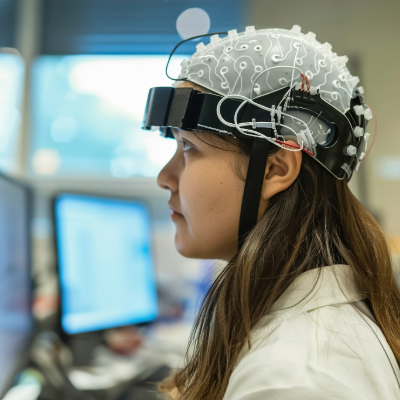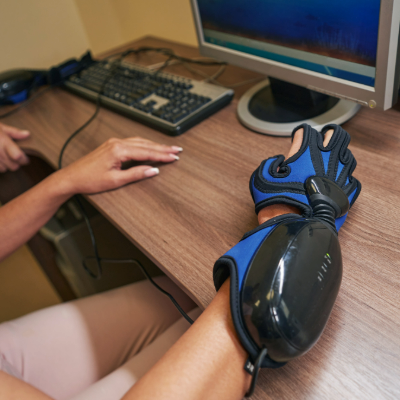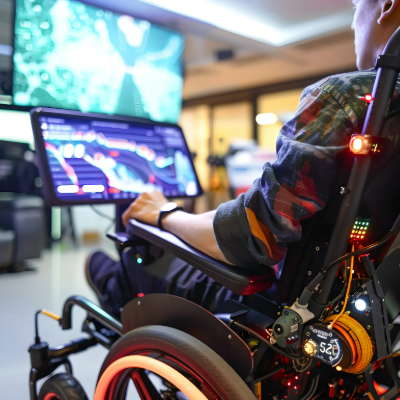Brain Computer Interface for Stroke Rehabilitation
Medically reviewed by Karen Murray, OT, CHT, CSRS - written by Stroke-rehab.com

A brain computer interface (BCI) is a technology that allows direct communication between a brain and an external device. It works by measuring the electrical activity in the brain using a technique called electroencephalography (EEG). When you think about moving a limb or performing a specific task, your brain generates unique patterns of electrical activity. A BCI can detect these patterns and translate them into commands that can control a computer or a robotic device.
For people who have had strokes, BCIs can be particularly beneficial. By thinking about moving a limb, even if they can't physically do so, their brain's electrical signals can be decoded by a BCI and used to control a robotic arm or other assistive device. This can help them regain some of their motor function.
While BCIs are still under development, they show promise as a potential tool for stroke rehabilitation and other neurological conditions.
Invasive vs Non-Invasive Brain Computer Interface
BCIs can be classified into two primary categories: invasive and non-invasive. Invasive BCIs involve surgically implanting electrodes or other devices directly into the brain tissue. This provides a more direct and precise connection, allowing for higher-resolution signals and potentially more complex control. However, invasive BCIs carry significant risks, including infection, inflammation, and tissue damage.
Non-Invasive BCIs utilize external sensors, such as those found in electroencephalography (EEG) caps, to measure brain activity. While these devices are less invasive and carry fewer risks, they produce weaker signals due to the distance between the sensors and the brain. This can limit the accuracy and complexity of the control that can be achieved.
Common Applications of Brain Computer Interfaces
Brain-computer interfaces have a wide range of potential applications. Here are some of the most promising:
- Restoring Mobility - BCIs can be used to help people with paralysis or disabilities regain some of their mobility. By decoding brain signals and translating them into commands, BCIs can control robotic limbs or wheelchairs, allowing users to perform tasks that were previously impossible.

- Enhancing Cognitive Functions - BCIs can be used to improve cognitive functions like attention, focus, and memory. For example, some headsets are designed to help users increase productivity and reduce distractions.
- Enabling Communication - BCIs can provide a way for people with severe communication impairments, such as those in a "locked-in" state, to interact with the world. By detecting subtle brain signals related to eye movements or thoughts, BCIs can allow users to spell words or control a computer cursor.

- Controlling Home Devices - BCIs can be used to control smart home devices, allowing users to perform tasks like turning lights on and off or changing the temperature without needing to physically move. This can be particularly beneficial for people with disabilities or limited mobility.
Companies Developing Brain Computer Interface Devices
Brain-computer interfaces (BCIs) are rapidly evolving, with several companies at the forefront. Here are a few examples:
Neuralink: This company, led by Elon Musk, is developing a coin-sized surgical implant that can monitor and potentially stimulate brain activity. Neuralink aims to treat conditions like paralysis and other neurological disorders.
Neurable: Neurable is focused on creating BCI-enhanced headphones that can improve focus and productivity. Their Enten headset uses advanced signal processing techniques to analyze brainwaves and identify optimal states for peak performance.
Precision Neuroscience: This company is developing a minimally invasive brain chip that can be implanted under the skull without damaging brain tissue. Their goal is to create a more seamless and reversible BCI system.
Synchron: Synchron is taking a different approach by placing a neuroprosthesis in the brain's blood vessels. This device can decode brain signals and allow users to control external devices with their thoughts.
Blackrock Neurotech: Blackrock has been at the forefront of BCI research for over two decades. Their devices have helped patients regain movement, control prosthetics, and even experience tactile sensations.
Neurolutions: Neurolution's flagship product, the IpsiHand device, is a device that uses brain-computer interface technology to help patients regain hand function after stroke or other brain injuries.
Brain-Computer Interface Challenges
The use of BCIs does have some challenges such as government regulations, cost, accessibility, and ethical considerations as discussed below.
Regulatory Hurdles
- Novelty: BCIs are a relatively new technology, and regulatory agencies like the FDA may lack established guidelines for their approval.
- Safety Concerns: Ensuring the safety of invasive BCIs, which involve surgical implantation, is a major concern.
- Lack of Precedents: The unique nature of BCIs makes it difficult to compare them to existing medical devices, making it challenging to determine the necessary evidence for approval.
Cost and Accessibility
- High Costs: BCIs, especially invasive ones, can be expensive to develop, manufacture, and implement.
- Insurance Coverage: Many health insurance plans may not cover the cost of BCI procedures or devices.
- Socioeconomic Disparities: The high cost of BCIs could exacerbate existing socioeconomic inequalities, limiting access to those with greater financial resources.
Ethical Considerations
- Privacy and Data Security: Concerns about the privacy of brain data and the potential for misuse of this information.
- Social or Economic Bias: Ensuring that BCIs are developed and used in a way that does not perpetuate social and economic biases or inequalities.
- Ethical Implications: Addressing the ethical implications of enhancing human abilities or altering brain function.
News Concerning Brain Computer Interface Technology
August 2024
- In a recent study conducted by UC Davis Health, researchers successfully implanted a BCI device into the brain of a man with amyotrophic lateral sclerosis (ALS), a progressive neurological disease that affects speech and muscle control. The BCI was able to decode the patient's brain signals and translate them into spoken words with remarkable accuracy, reaching up to 97% accuracy.
- A second human patient has successfully used a Neuralink brain-computer interface to control a video game with their mind. The patient, who previously relied on a mouth-operated assistive device, was able to navigate and aim in the game "Counter-Strike 2" using only their thoughts. This significant advancement highlights the potential of BCI technology for restoring movement and communication in individuals with disabilities.
April 2024
- Neurolutions' IpsiHand received The Centers for Medicare and Medicaid Services (CMS) approval for a new HCPCS code for its IpsiHand Upper Extremity Rehabilitation System. This marked the first time a brain-computer interface (BCI) controlled therapy had been recognized by CMS.
Further Research and Development Needed
While significant advancements have been made, further research and development are needed to address the challenges and limitations associated with BCI technology. As technology continues to evolve, we can expect to see even more innovative and effective BCI-based therapies for stroke rehabilitation.
Get Our Stroke Rehab Guide

Our stroke rehab guide is designed specifically for patients and caregivers. It's in pdf format and can be immediately downloaded. It includes about
- Stroke Definition & Causes
- Stroke Treatment
- Rehabilitation Information for Physical, Occupational and Speech Therapy
- Exercise pictures
- Q&A from patients and caregivers
- Adaptive Equipment & Techniques
- How to Prevent Another Stroke & More!
Medical Disclaimer: All information on this website is for informational purposes only. This website does not provide medical advice or treatment. Always seek the advice of your physician or other healthcare provider before undertaking a new healthcare or exercise regimen. Never disregard professional medical advice or delay seeking medical treatment because of something you have read on this website. See the disclaimer page for full information.
- Home
- Guide to Exercises
- Brain Computer Interface













